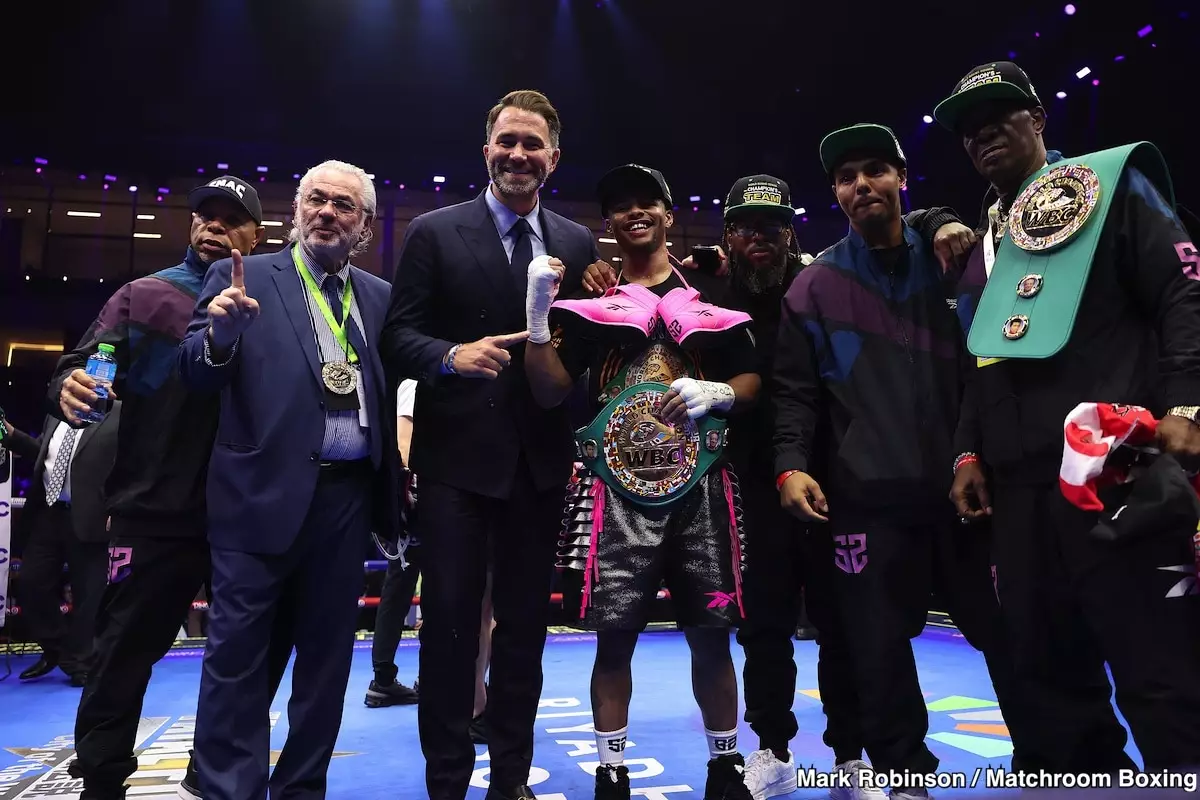Eddie Hearn, the prominent boxing promoter, has placed his bets on an electrifying matchup between Shakur Stevenson, the reigning WBC lightweight champion, and William Zepeda, the interim titleholder. Hearn believes this fight could materialize in Newark, New Jersey, the hometown of Stevenson, and is optimistic about negotiating terms with Golden Boy Promotions’ Eric Gomez to bring this bout to fruition. The announcement has triggered excitement among fans and boxers alike, but it also raises questions about the feasibility of Hearn’s grand plans.
Hearn’s ambition to stage a “5v5” style event, integrating the Stevenson-Zepeda fight, indicates his desire to revolutionize the boxing experience. By pairing several matchups to create an engaging event, he aims to attract a more extensive audience. However, the idea of blending various fights on a single card, while appealing, may oversimplify the complexities of boxing matchmaking, especially when considering Zepeda’s and Stevenson’s contrasting market appeal.
A Glimpse Into the Stakes
Stevenson is under significant pressure to reclaim his standing in the sport following a disappointing performance against Edwin De Los Santos. Despite being a talented fighter, Stevenson’s fan perception has waned, leading critics to question his ability to attract audiences in the same manner as more charismatic fighters like Gervonta “Tank” Davis. For Stevenson, defeating a fan-favorite like Zepeda presents an opportunity to reinvigorate his brand and establish his market worth.
While Hearn asserts that both fighters have plenty to gain from this matchup, a closer look reveals that Stevenson has more at stake than Zepeda. For Zepeda, this fight is critical but primarily solidifies his position in the sport without the added pressure of needing to boost his marketability.
Unquestionable Motivations and Challenges
The ultimate goal for Stevenson seems clear: engage in a high-profile unification battle against Davis following a win over Zepeda. Hearn has emphasized that Stevenson needs this victory to entice Davis into the ring. However, this expectation appears overly optimistic. Can Stevenson indeed elevate his status enough to lure one of boxing’s biggest names? The odds are stacked against him.
Stevenson’s performance against Zepeda is paramount. If he fights similarly to his last outing—focused on evasion and scoring points rather than aggression—audiences are likely to react unfavorably. Boxing fans typically celebrate high-energy bouts, and a tactical retreat could lead to a hostile reception, tarnishing his reputation further.
The Reality of Promoting Big Fights
Hearn’s commentary reflects a promotional landscape fraught with complexities. The ideal scenario for Hearn is a lucrative event in Newark; however, whether Zepeda will agree to fight in Stevenson’s hometown remains dubious. There’s a fundamental conflict between ensuring fighter safety and negotiating favorable financial terms. While Stevenson has prospered in Newark with million-dollar gates, Zepeda’s interest in a more balanced purse distribution cannot be overlooked.
Further complicating matters is the current golden age of boxing in the Middle East. The financial allure of Saudi Arabia has transformed the fight promotions landscape. If a significant offer arises from there, it could shift the conversation entirely, leaving the Newark plan in jeopardy. Hearn’s awareness of this reality shines through when he discusses the financial ‘premium’ attached to fights in Saudi Arabia compared to U.S. events.
The Dynamics of Modern Boxing Promotions
Hearn’s dialogue indicates an adaptive mindset, grappling with the pressing challenges and opportunities inherent in contemporary boxing. He recognizes the need to keep both fighters satisfied while navigating the financial waters of independent and major promotions. This recognition illustrates an understanding that boxing is not merely about the fight, but about creating an ecosystem where fighters can thrive financially and where fans can engage fully.
Ultimately, while the prospect of a Stevenson-Zepeda matchup excites, the logistical and financial uncertainties outline the challenges ahead. Fans can only hope that both parties find common ground to bring forth a fight that could potentially reshape the lightweight division for years to come. In a sport guided by unpredictable turns and pressures, the narrative of Shakur Stevenson and William Zepeda resonates, presenting a compelling chapter that could redefine their careers.

